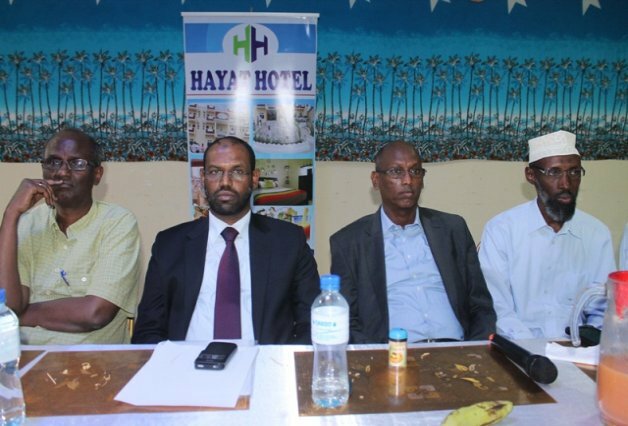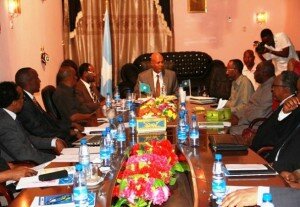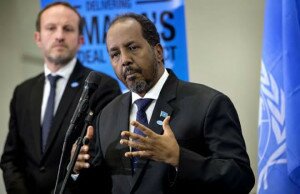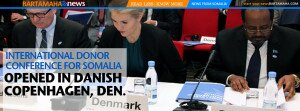AU plots final assault on militants
 Peaceful Somalia: Continental organization seeks to establish a standing force following realization the militants still have presence, but they can be overcome with strengthening of security in liberated areas
Peaceful Somalia: Continental organization seeks to establish a standing force following realization the militants still have presence, but they can be overcome with strengthening of security in liberated areas
The African Union has embarked on a serious ideological offensive as a final assault on the Al Shabaab militants, who still pose a major security threat in Somalia despite the successes of the African intervention force to eject them from their strongholds.
The ideological reorientation in Somalia starts at a time when the continental body is toying with the proposal to form a standing army to intervene in politically and resource-instigated conflicts on the continent.
The second phase of Somali pacification that started immediately the key port of Kismayu was wrested from Al Shabaab by Kenya soldiers serving under the African Mission in Somalia contingent (Amisom) faces the challenges of establishing a standing national army to take over from Africa forces.
Amisom mandate was in August extended by one year by the UN Security Council. In the absence of a strong army, the stability of Somalia in liberated areas remains shaky.
Speaking to The Standard On Sunday, Kenya Defence Force (KDF) Spokesman Col Cyrus Oguna avers that the physical ejection of Al Shabbab from its strongholds can only make sense with the ideological realignment of the ordinary people, which starts with the provision of basic services.
Strong resistance
“Al Shabaab was a physical entity, which currently lacks the ability to wage strong resistance. For there to be successful, there is need to wage an ideological programme through working institutions of governance. At present the only semblance of governance is Mogadishu and Kismayu where systems are being put in place as the reality of the defeat of Al Shabaab begins to take effect,” explains Oguna.
Initially, Kenyan troop were scheduled to be in Somalia for three months after creating a buffer zone along the two countries’ common border to prevent Al Shabaab incursions.
This followed a serious of abductions of humanitarian workers and tourists at the Coast. However, one year and three months later, KDF troops are still deployed in southern Somalia to mop up any remnants of Al Shabaab, while at the same time helping the new government create administrative institutions.
Oguna says Amisom has helped create a modicum of law and order in Mogadishu and Kismayu.
On his first visit to Kenya since he was elected in August, President Hassan Mahmud Hassan, told President Kibaki his country still faces a serious security challenge. Mahmud wants Amisom troops to remain in Somalia to train national army and police to takeover from the African forces.
The AU headquarters holds the same view. In a past interview with The Standard On Sunday, Amison force commander Lt-Gen Andrew Gutti acknowledged the daunting task the country faces. Lt-Gen Gutti said the liberated areas are a long way from security.
Sniper fire and remote-controlled bombs are the latest armour in Shabaab’s ever-changing tactics to repulse the Amisom onslaught, presents the fragile government with many challenges to deal with in the first place.
Far from over
AU Spokesman and Head of Public Information Unit Eloi Yao is of a similar view, saying stabilisation of Somalia is far from over despite the optimism precipitated by the weakening of Al Shabaab activities in the war-ravaged Horn of African state.
“Efforts are being focused on national stability plans and establishment of local administrations in liberated areas,” Yao says. He acknowledges the challenge the Horn of Africa faces before the new Somali government can stand on its own. On his inauguration two months after winning the first election to be conducted on Somali territory in more than four decades, President Mahmud spoke emphatically about the need for security as key for reconstruction more than two decades conflict.
To Kenya and other member-states of Inter-Governmental Authority on Development, Somalia remains problematic.
“The radical elements are still among the people. The political process must move in to repulse the Al Shabaab radicalism. There is need to explain to the people what is happening so that the people can own the process,” says Oguna.
Inter-clan suspicions and hostilities remain alive and without an effective central government and regional administrations. Oguna admits a relapse into fighting is a high possibility.
In the meantime, the African Union plans to have standing army to intervene in conflicts on the continent. Contacted, AU Spokesman Eloi Yao confirmed the proposal the proposal is an initiative of the continental body’s Peace and Security Council.
The formation of a standing force was made the agenda of an international conference held in Dakar, Senegal, last week.
The AU conference discussed security and conflicts in Africa with fears growing that democracy had been relegated to the backburner. The fears come on the back of new conflicts in Mali, Central African Republic, the Democratic Republic of Congo and Chad, among others.
It is understood that the proposal to have continental force was mooted following disputed presidential election results in Kenya and Zimbabwe.
The two countries experimented with power sharing, a model Ivory Coast, which nearly went the Kenya and Zimbabwe way after former President Gbagbo refused to cede power to then opposition leader Ouattara.
“The formation of an African Union standing army is work-in-progress. Its realisation actually depends on the willingness of the African governments to donate troops,” says Yao.
Source:- Standard media
Comments
comments
 Calendar
Calendar






































